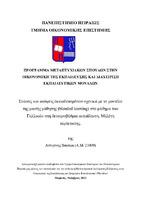Στάσεις και απόψεις εκπαιδευομένων σχετικά με το μοντέλο της μικτής μάθησης (blended learning) στο μάθημα των γαλλικών στη δευτεροβάθμια εκπαίδευση. Μελέτη περίπτωσης
Exploring High School students’ perceptions and practices on the implementation of blended learning in French courses. Case study

View/
Keywords
Μικτή μάθηση ; Ανεστραμμένη τάξη ; Γαλλικά ; Συστήματα διαχείρισης μάθησης ; Πλατφόρμα e-class ; Διαδικτυακή μάθηση ; Δια ζώσης διδασκαλίαAbstract
Blended learning, a method that combines face-to-face with online distance activities
with ICT support, emerged as one of the most popular pedagogical concepts in the early
2000s.
In the past, the lack of technological availability prevented the combination of
traditional face-to-face learning with collaborative distance learning environments.
However, in the last 20 years the introduction of new technological innovations has
filled this void. As new learning models proliferate, an increasing number of students
will use online learning as part of their learning path (Bailey et al., 2013, p.4). Graham
(2006, p.7) stated that blended learning will play a big role in the future.
Recent technology developments are encouraging teachers to implement
blended learning in their classrooms, and there are many who strongly support this
method. But what happens from the students’ side? What do they think about this new
method?
In this paper, we have studied the attitudes and opinions of 1st grade Lyceum
greek students in the context of conducting French language lessons using the Blended
Learning method, specifically the flipped classroom model. The results of the research
showed that most students had a positive attitude towards this method. They have noted
that the use of technology in learning is a major advantage of the method. However,
there were also negative impressions, such as the difficulty in carrying out lessons when
there is no good or no internet connection at all.


